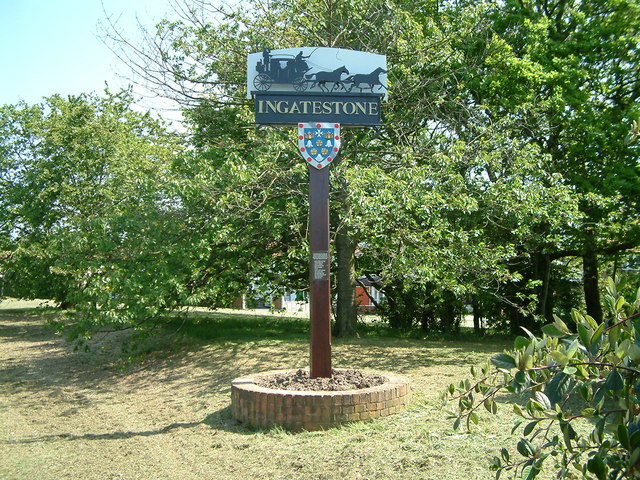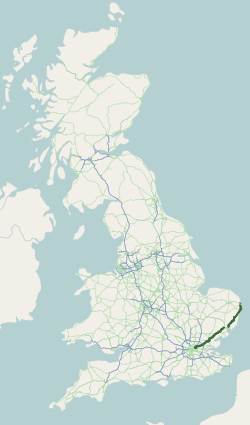|
Heybridge, Brentwood
Heybridge is an urban settlement in Brentwood (borough), Brentwood borough of Essex, England, contiguous with the village of Ingatestone. The main development comprises a mixture of houses and bungalows which were built in 1954 on land owned by the Coal Board and an area of local authority housing. It is on the course of a Roman Road. This was formerly the A12 road (England) until it was by-passed in the 1970s: Heybridge can be accessed from junction 13 of the A12 (Truelove's Interchange). The residential development is bounded by the railway line and River Wid to the south beyond which is rolling agricultural land. Heybridge is within walking distance of Ingatestone railway station. Ingatestone Hall is nearby. {{coor, 51.65, N, 00.35, E, region:GB, display=title Populated places in Essex Borough of Brentwood ... [...More Info...] [...Related Items...] OR: [Wikipedia] [Google] [Baidu] |
Brentwood (borough)
The Borough of Brentwood is a local government district and borough in Essex in the East of England. History and geography The borough is named after its main town of Brentwood. There are still large areas of woodland including Shenfield Common, Hartswood (named after its last private owner, a Mr. Hart), Weald Country Park, and Thorndon Country Park. The original district council was formed in 1974 from the former area of Brentwood Urban District, part of Epping and Ongar Rural District and part of Chelmsford Rural District. By royal charter, the district became a borough on 27 April 1993. Politics The council has 37 councilors, divided between 15 wards with between 1 and 3 councilors. Following the United Kingdom local elections in 2021 the political composition of Brentwood Borough Council is as follows: Boundaries Brentwood is bordered by Epping Forest district (to the north-west), Chelmsford (north-east), Basildon district (south-east), Thurrock (south, aligned wi ... [...More Info...] [...Related Items...] OR: [Wikipedia] [Google] [Baidu] |
Essex
Essex () is a county in the East of England. One of the home counties, it borders Suffolk and Cambridgeshire to the north, the North Sea to the east, Hertfordshire to the west, Kent across the estuary of the River Thames to the south, and Greater London to the south and south-west. There are three cities in Essex: Southend, Colchester and Chelmsford, in order of population. For the purposes of government statistics, Essex is placed in the East of England region. There are four definitions of the extent of Essex, the widest being the ancient county. Next, the largest is the former postal county, followed by the ceremonial county, with the smallest being the administrative county—the area administered by the County Council, which excludes the two unitary authorities of Thurrock and Southend-on-Sea. The ceremonial county occupies the eastern part of what was, during the Early Middle Ages, the Anglo-Saxon Kingdom of Essex. As well as rural areas and urban areas, it forms ... [...More Info...] [...Related Items...] OR: [Wikipedia] [Google] [Baidu] |
Ingatestone
Ingatestone is a village and former civil parish in Essex, England, with a population of 5,365 inhabitants according to the 2011 census. Just north lies the village of Fryerning, the two forming now the parish of Ingatestone and Fryerning. Ingatestone lies in the Metropolitan Green Belt 20 miles (32 km) north-east of London. Its built-up area straddles the A12 trunk road and the Great Eastern Main Railway Line. It has become an affluent commuter village, seen as one of the UK's best places to live by the Sunday Times in 2020. History Ingatestone appeared in Saxon times on the Essex Great Road (now the A12) between the Roman towns of Londinium (London) and Camulodunum (Colchester). The name means "Ing at the Stone", the suffix distinguishing it from nearby settlements that also formed part of the manor of Ing. It is first recorded in 1283 as ''Gynges atte Ston''. Stone is not prevalent in the local geology. The village stone, deposited by glacial action, is unusual for t ... [...More Info...] [...Related Items...] OR: [Wikipedia] [Google] [Baidu] |
Roman Road
Roman roads ( la, viae Romanae ; singular: ; meaning "Roman way") were physical infrastructure vital to the maintenance and development of the Roman state, and were built from about 300 BC through the expansion and consolidation of the Roman Republic and the Roman Empire. They provided efficient means for the overland movement of armies, officials, civilians, inland carriage of official communications, and trade goods. Roman roads were of several kinds, ranging from small local roads to broad, long-distance highways built to connect cities, major towns and military bases. These major roads were often stone-paved and metaled, cambered for drainage, and were flanked by footpaths, bridleways and drainage ditches. They were laid along accurately surveyed courses, and some were cut through hills, or conducted over rivers and ravines on bridgework. Sections could be supported over marshy ground on rafted or piled foundations.Corbishley, Mike: "The Roman World", page 50. Warwick Press, ... [...More Info...] [...Related Items...] OR: [Wikipedia] [Google] [Baidu] |
A12 Road (England)
The A12 is a major road in Eastern England. It runs north-east/south-west between London and the coastal town of Lowestoft in the north-eastern corner of Suffolk, following a similar route to the Great Eastern Main Line until Ipswich. A section of the road between Lowestoft and Great Yarmouth became part of the A47 in 2017. Between the junctions with the M25 and the A14, the A12 forms part of the unsigned Euroroute E30 (prior to 1985, it was the E8). Unlike most A roads, this section of the A12, together with the A14 and the A55, has junction numbers as if it were a motorway. The section of the A12 through Essex has sections of dual two lanes and dual three lanes, with eight changes in width between the M25 to Ipswich. It was named as Britain's worst road because of "potholes and regular closures due to roadworks" in a 2007 survey by Cornhill Insurance. The A12 is covered by Highways England's A12 and A120 Route Management Strategy. Starting just north of the Blackwall Tu ... [...More Info...] [...Related Items...] OR: [Wikipedia] [Google] [Baidu] |
Ingatestone Railway Station
Ingatestone railway station is on the Great Eastern Main Line in the East of England, serving the village of Ingatestone, Essex. It is down the line from London Liverpool Street and is situated between to the west and to the east. Its three-letter station code is INT. The station is currently managed by Greater Anglia, which also operates all trains serving it, as part of the East Anglia franchise. History The first station at Ingatestone was opened by the Eastern Counties Railway (ECR) in July 1843, sited just below Stock Lane, and operated for less than a month. The station consisted of wooden platforms on each side of the railway, connecting to the road carried above by wooden steps up the embankment. However, the agreement for the construction of the railway across the Petre Estate, obtained in 1836, and section 7 of the enabling private Act of Parliament (''An Act to amend and enlarge the powers and provisions of the Act relating to the Eastern Counties Railway'') in ... [...More Info...] [...Related Items...] OR: [Wikipedia] [Google] [Baidu] |
Ingatestone Hall
Ingatestone Hall is a Grade I listed 16th-century manor house in Essex, England. It is located outside the village of Ingatestone, approximately south west of Chelmsford and north east of London. The house was built by Sir William Petre, and his descendants ( the Barons Petre) live in the house to this day. Part of the house is leased out as offices while the current Lord Petre's son and heir apparent lives in a private wing with his family. The Hall formerly housed Tudor monarchs such as Queen Elizabeth I. The hall is open to the public on selected afternoons between Easter and September. History William Petre bought Ingatestone manor soon after the Dissolution of the Monasteries for some £850 and commissioned the building of the house. In June 1561, Queen Elizabeth I spent several nights at Ingatestone Hall on her royal progress, where she held court. The Petre family laid on a lavish welcome, procuring food and drink and decorating the house. In November 1564, Lady ... [...More Info...] [...Related Items...] OR: [Wikipedia] [Google] [Baidu] |
Populated Places In Essex
Population typically refers to the number of people in a single area, whether it be a city or town, region, country, continent, or the world. Governments typically quantify the size of the resident population within their jurisdiction using a census, a process of collecting, analysing, compiling, and publishing data regarding a population. Perspectives of various disciplines Social sciences In sociology and population geography, population refers to a group of human beings with some predefined criterion in common, such as location, race, ethnicity, nationality, or religion. Demography is a social science which entails the statistical study of populations. Ecology In ecology, a population is a group of organisms of the same species who inhabit the same particular geographical area and are capable of interbreeding. The area of a sexual population is the area where inter-breeding is possible between any pair within the area and more probable than cross-breeding with in ... [...More Info...] [...Related Items...] OR: [Wikipedia] [Google] [Baidu] |





